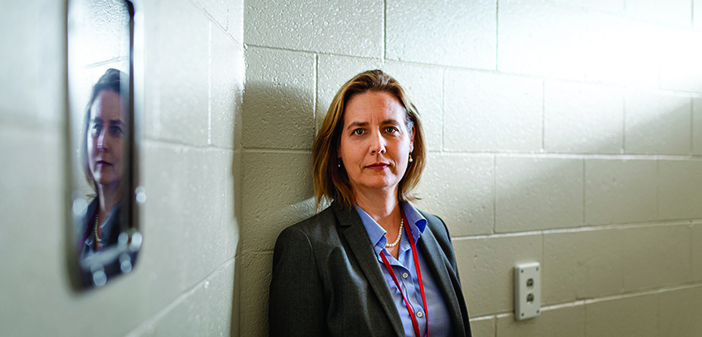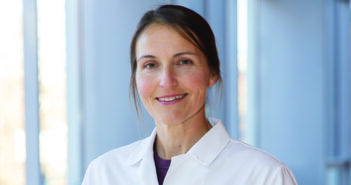A cadre of medical and legal advocates cares deeply about the health of people behind bars.
In 2005, Bradley Brockmann, JD ’76 was working in Boston as a civil rights litigator for Prisoners’ Legal Services of Massachusetts. On December 20, Nelson Rodriguez, a 26-year-old man with a cognitive disability and mental illness, hanged himself in Cell 49 of the isolation unit known as 10 Block in the maximum security prison in Walpole, MA. Brockmann and colleagues went to the prison the next day to begin interviewing the other 25 men on the tier, who claimed that Rodriguez had spent the night screaming for help and received none.
Brockmann describes those interviews as “horrendous,” but the experience shaped the way he sees the problem of incarceration. “What I came to understand over time was that virtually all of my clients—dozens and then hundreds—had a substance use issue and/or a mental health disorder. And that is what’s driving recidivism in our prison system: individuals with co-occurring mental health and substance use disorders.”
He’s not wrong. According to the Bureau of Justice Statistics, more than half of inmates in US state prisons have a mental health problem, and three-quarters of those individuals also meet the criteria for substance dependence or abuse.
At Brown, physicians and public health and policy experts like Brockmann have joined ranks under the aegis of the Center for Prisoner Health and Human Rights. Based at The Miriam Hospital, the center and its affiliated physicians and advocates work to develop programs to enhance continuity of care for released prisoners, as well as diversion programs to keep individuals with behavioral health disorders out of the justice system in the first place.
The Other 1 Percent
The number of people behind bars with mental illness and addiction has been a disaster decades in the making, the result of two social policies that have arguably exacerbated the problems they purported to solve.
President Nixon’s 1971 declaration of a “war on drugs” opened the door to a host of harsh penal policies for relatively minor drug offenses. The contribution of such policies to America’s current epidemic of incarceration is widely acknowledged. Since 1981, when the “war” began in earnest, the number of people incarcerated for drug possession has swelled by 500 percent, from 41,000 to almost half a million. By 2012, 1 in 108 adults—nearly 1 percent of the American adult population—was behind bars.
Around the same time, many people with mental illness found themselves on the street, thanks to the well-intentioned deinstitutionalization movement. Starting in the 1950s and gaining momentum in the ’70s and ’80s, deinstitutionalization aimed to take psychiatric patients out of state hospitals, where conditions were often deplorable, and move them into group homes, where they could live with more autonomy and dignity. The idea took: in 1950, there was one psychiatric bed for every 300 Americans; by 2004, there remained one for every 3,000.
Radical cuts to federal mental-health funding, however, meant that the vast majority of planned facilities were never built. Patients were discharged with nowhere to go and no one to oversee their care. Many became homeless—and many ended up in jail or prison. By 2004, there were three times more individuals with serious mental illness in jails and prisons than in psychiatric hospitals. As the Boston Globe put it in a 2005 series on suicide in prison, the “inmate[s]now flooding the corrections system [are]the mentally ill for whom prison is increasingly the asylum of last resort.”
The last resort—and for many, the last place they should be. Some, such as Rodriguez, end up in solitary confinement (also known as segregation), which can be psychologically damaging to a healthy person, let alone someone with a major mental disorder like schizophrenia. In one federal case, a judge ruled that “putting mentally ill prisoners in segregation is the mental equivalent of putting an asthmatic in a place with little air.” And once they’re in the system, the exit is more of a revolving door. People with certain mental health issues, such as ADHD, can have difficulty in the highly regimented environment of prison, which only exacerbates their problems. “They can’t follow orders—they spiral,” Brockmann says. They rack up disciplinary infractions for noncompliance or simply “bizarre” behaviors. If they’re released, they go untreated and fall into the same problematic behaviors as before. One-quarter of state prisoners with mental health problems have been incarcerated at least three times.
The “collision” of her patients’ lives with the law intrigued Christine Montross MD’06 MMS’07 RES’10. A psychiatrist in the intensive treatment units at Butler Hospital and assistant professor of psychiatry and human behavior, she deals with the most severe cases of psychiatric illness. “I noticed over the years that many of the patients I treat come into contact with the criminal justice system,” she says. “The questions that began to arise for me were ‘Why?’ and ‘What happens when they do?’”
The answer, often, is that they get into trouble and they can’t get out. In a 2016 paper published in the New England Journal of Medicine, Montross described a man suffering from paranoia who was ordered to leave a convenience store, refused, and was taken to jail. There, still paranoid, he refused to take antipsychotic medication and had to be forcibly removed from his cell. The man fought back, further worsening his plight by being charged with assaulting an officer—a felony. Instead of being treated for his mental illness, he’s likely to spend years, probably without adequate psychiatric care, in a carceral setting that will only make his mental condition worse.
“If we recognize that prison or jail is not the appropriate first place for these people, then we need to have systems in place to offer support and treatment,” Montross says. “Any of us could [have a psychiatric illness]at any point in our lives. Rather than see these people as ‘other,’ we must see them as vulnerable, and work for their care and protection.”
In 2015, Montross received a Guggenheim fellowship to support research for a book about the intersection of mental illness and the criminal justice system, and has used it to study correctional facilities from Cook County Jail, in Chicago, to Norway’s maximum-security Halden Prison. “Our society at times takes a simplistic and comfortable view that anyone who ends up in [jail]belongs there. … We’ve adopted a position that is more punitive than rehabilitative,” Montross says. In contrast, the Norwegian approach is to use the time of incarceration productively, to equip prisoners with skills so that they emerge able to thrive in and contribute to society. “That,” she says, “is a very logical approach.”
One promising step in the right direction is the 21st Century Cures Act, which former President Barack Obama signed into law in December. The legislation includes initiatives to reduce mental illness and addiction in the criminal justice system, including community treatment, diversion, and reentry programs, as well training programs for police and first responders. Says Brockmann: “Here in Rhode Island, the center is working with law enforcement agencies, the public defender, the mental health advocate, and other state actors to create an effective pre-arrest diversion program for individuals who need treatment, not jail, when they have a behavioral issue. We are optimistic that federal funding will help us move this forward.”
Treating Addiction Like the Disease It Is
Prisoners are among the unhealthiest Americans, beset not only by mental and substance use disorders, but by chronic diseases such as asthma and diabetes and communicable diseases such as tuberculosis, HIV, and viral hepatitis—all of which are significantly more prevalent behind bars than in the community. Studies have found health care is uneven, with prisoners in short-stay settings such as jails getting the least amount of care.
Yet where most people would see a human health disaster, some see a chance to turn the tide.
“Make no mistake. Overincarceration is bad for families, for communities, for society. It would be far better to dramatically reduce incarceration rates with more appropriate interventions that can lead to better outcomes for everyone. But given that this high-risk population finds itself in an institution temporarily, it would be foolish not to capitalize on the health and public health opportunities that presents,” says Professor of Medicine Josiah “Jody” Rich, MD, MPH, who has been treating prisoners in the Rhode Island Department of Corrections (RIDOC) for almost a quarter-century.

AVENGERS UNITE: The staff of the Center for Prisoner Health and Human Rights, from left to right: Michelle McKenzie, senior project director; Jody Rich, cofounder and director; Milly Perez-Cioe, executive secretary; Alex Macmadu, senior research assistant; Heather Gaydos, reentry project manager; Sarah Martino, project director; Bradley Brockmann, executive director. Photo by Patricia D’Aiello
Working with fellow Brown infectious disease docs Scott Allen MD’91 RES’94 (who is now at the University of California, Riverside), Timothy Flanigan, MD, Curt Beckwith MD’99 RES’02 F’05, Charles Carpenter, MD, and others, Rich has helped make Rhode Island a model for correctional health programs that address infectious diseases and substance abuse. Early on, he saw prison as an ideal place to make inroads into the HIV/AIDS epidemic as well as drug addiction, thanks to the, well, captive audience. (Rich is also known for helping change Rhode Island’s five-year felony sentence for possession of syringes—“the craziest law in the country”—after years of advocating for a needle exchange program. Once sterile needles became available, the rate of HIV transmission dropped significantly.)
Today Rich is tackling another scourge from inside the walls: opioid use disorder. According to the Centers for Disease Control and Prevention, over the past decade and a half, the rate of deaths in the United States from drug overdose has increased 137 percent—and the rate of deaths involving opioid overdose has risen 200 percent. Two pernicious trends underlie this new epidemic: the dramatic rise in prescribing opioid pain relievers, and the availability of heroin and its evil cousin, fentanyl, a prescription synthetic opioid 50 to 100 times more potent than morphine.
Rhode Island has not been spared. In 2013, the smallest state in the union earned the dubious double distinction of having the highest rate of illicit drug use in the country and the highest rate of drug overdose in New England. In August 2015, Governor Gina Raimondo took action, establishing the Overdose Prevention and Intervention Task Force, which includes both policymakers and medical experts—Jody Rich among them. The group released Rhode Island’s Strategic Plan on Addiction and Overdose last November. The goal of the plan is to reduce overdose deaths in the state by one-third within three years. Its strategy relies on intense collaboration among the Department of Health, RIDOC, insurers, and other agencies to, among other things, increase distribution of naloxone, widely known as Narcan and a key lifesaver in cases of opioid overdose, and expand treatment for people on opioid agonists such as methadone.
Medication-assisted treatment, or MAT, combines behavioral therapy and medications—methadone, buprenorphine (commonly known as Suboxone), or Vivitrol—to treat opioid use disorder. Although methadone has been FDA-approved since 1972 and is recommended by the World Health Organization, opponents object to what they perceive as rewarding offenders rather than punishing them, or as replacing one addiction with another. But forced withdrawal, which is still the rule in the vast majority of US prisons and jails, has dire consequences both for the individual—it’s notoriously painful—and for society.
Methadone maintenance is more effective at keeping people alive: because an individual taken off methadone develops a much lower tolerance, he is at a much higher risk of overdose—and death—if he uses again on the outside. In a study released last year, Rich and others showed that keeping prisoners on methadone makes them twice as likely to seek treatment after they get out—and therefore much less likely to engage in drug-seeking behaviors, such as stealing.
Then there’s the ethical dimension: in a paper that appeared in a special series of the Lancet in July 2016, Rich wrote that exacerbating imprisonment with “the physical and psychological burdens of opiate withdrawal … amounts to a double punishment.” Further, he spotlights society’s double standard when it comes to substance abuse. “We don’t take [prisoners]off their blood pressure medicine, we don’t take them off their diabetes medicine,” he says. “When you take someone off [opioids]you cause predictable pain and suffering. I thought we were medical professionals. I thought we were supposed to be alleviating pain and suffering.”
Epidemic Proportions
Late on a Monday night last July, Rich returned to Providence from the International AIDS Society meeting in Durban, South Africa, where he had presented a paper on HIV, viral hepatitis, and tuberculosis among prisoners. The next morning, jet-lagged, he rounded on patients at his AIDS clinic at RIDOC in Cranston. That’s when he got a call from colleague Jennifer Clarke, MD RES’96 F’98 MPH’04.
“Jennifer said, ‘There are a couple of women interested in starting medication-assisted treatment for opiate use disorder. Can you go over to the women’s division and get them started?’” Rich recalls. When he got there, the nurse told him there weren’t two, but a dozen women who wanted to begin the treatment. He didn’t leave the prison until after dark—as usual, on his bike.
“I’m riding home that night having just heard all these heart-wrenching stories about how people did not get connected to treatment … I just wanted to cry,” Rich says. “Why haven’t we been doing this all these years? But now we’re doing it. Every Tuesday since then we’ve been getting people started as quickly as possible. That’s what’s exciting me these days.”
Last year, Governor Raimondo secured $2 million for the 2017 fiscal year to expand the MAT program, which is now available to eligible inmates for six months to one year. Some 120 RIDOC inmates are on the program on a daily basis, with plans to accommodate 300 a day—not only individuals already on methadone when they enter prison, but also those who aren’t but could benefit from it.
The urgency of the Task Force’s work intensifies daily. On average four Rhode Islanders die of overdose every five days. Last year 80 percent of overdose deaths in the state involved illicit drugs, and half of those involved fentanyl. Notably, 21 percent of 2014 and 2015 victims had been incarcerated in the two years before death.
Clarke, an associate professor of medicine, agrees with Rich that prison is fertile ground for improving people’s health. Back in 1998, as she was completing a fellowship in women’s health at Brown, she knew she wanted to work with the underserved and heard there was a job at RIDOC’s women’s facility. “I was the only one who thought that sounded amazing,” she recalls. “So I got it.”
For the next 18 years, she provided primary care to the female (and eventually male) prison population, and authored studies on the reproductive health and perinatal care of incarcerated women and on the practice of shackling pregnant inmates during labor and delivery.
But in December 2015, Clarke traded her white coat for a gray suit and became RIDOC’s medical programs director. Now, instead of directly caring for individuals, she juggles the meetings, emails, and problem-solving that come with overseeing the health care of more than 3,100 inmates—not to mention the thousands of individuals who pass through on a short-term basis. Although she has been called a “drug pusher” by those who oppose MAT, she is quick to make the case for its merits, which include cost effectiveness.
“For every dollar we spend on substance use treatment, we save 7 to 12 dollars,” she says. “It’s a win-win.”
To Clarke, inaction is unacceptable. “We’ve all heard the definition of insanity: you keep doing the same thing over and over and expect different results. We’re there. We know we have to do something different. We have leadership here, with the governor and [RIDOC Director] A.T. Wall. They are really forward-thinking and want to do the right thing, even if it might not feel good in the moment,” she says.
Like Brockmann, Montross, and Rich, Clarke considers caring for prisoners a matter of social justice. For many inmates, the medical attention they receive from RIDOC is more than what they were getting on the outside. The irony that for some people prison is the best thing that ever happened to them, at least where health care is concerned, is not lost on Clarke.
“One of the saddest things I hear is when someone says, ‘Thank God I was incarcerated. Otherwise I’d be dead.’ That really speaks to how unstable some people’s lives are in the community: lack of housing, violent relationships, substance use, mental health problems where they can’t get treatment,” she says. “[This] can be a time out for someone who’s here for 30, 60, 90 days. We’re not primarily a social service organization. … But for people whose lives are chaotic, for whom this is a better place, I feel it’s really important to take that opportunity to provide health care.”
Hi, Neighbor
Even with the most caring and effective doctors on the inside, an inmate’s troubles may start all over again when he or she is released. Rich compares reentry to “walking out of a cabin into a blizzard. Where are you going to get money? Your next meal? What about the voices you hear? How do you keep from getting beaten up? You’ve also got a lot of people with a vested interest in your picking up drugs again.” Sixty percent of inmates with a substance use disorder relapse within two weeks after their release.
It helps to have a supporter in the community. If you’re lucky, it will be someone like Lynn E. Taylor, MD RES’00 F’05, a fiercely committed advocate for the marginalized and the stigmatized, with a special focus on people infected with hepatitis C virus (HCV). She is director of the HIV/Viral Hepatitis Coinfection Clinic at The Miriam Hospital and founder of Rhode Island Defeats Hep C, a project dedicated to the elimination of HCV in the Ocean State. RID Hep C’s goals include ensuring all electronic medical record systems in the state include a prompt for one-time HCV screening of baby boomers, who, along with people who inject drugs, are most at risk of carrying the virus.
“I’m trying to help individuals while working on affecting system-level improvements,” Taylor says.
One such individual is Paul Kelly, a 50-something man whose life story reads like that of so many caught in the cycle of incarceration, drug use, and illness: arrested at 14 for stealing, he’s been in and out of prison for most of his life. He contracted HIV by injecting drugs while on the inside, where he contracted hepatitis C as well. Off and on for the past 18 years, he’s been treated by Rich in prison and by Taylor on the outside.
Taylor, who is an assistant professor of medicine (clinical), says: “How do you really effect change? You hang in over time. Jennifer Clarke and Jody Rich have been doing this for years and years. They met many of our patients in the DOC, diagnosed them with HIV and HCV, became their docs, and said, ‘I will stand by you through whatever for forever.’ A lot of patients have never had that—not with a family member or friend, not ever. The continuity of care and investment by physicians helps people endure and improve their health and lives.”
Kelly did endure, but not without a lot of effort—and some setbacks along the way, including a few relapses and stints in federal prison. Today, thanks to Rich and Taylor and his own resilience and determination, Kelly is sober and HCV free. He lives in AIDS Care Ocean State’s Sunrise House, a drug- and alcohol-free facility for people living with HIV, and works in construction.
“I’m not on probation, I’m not on parole,” he says, smiling. “I’m free. I haven’t had that since I was 14 years old.”
Kelly is among the 95 percent of incarcerated people who are ultimately released. That’s 12 million individuals a year returning to their communities. Put that way, it’s hard to keep seeing the health of prisoners as something that only matters behind bars. As Brockmann says, “Prisoner health is public health.” The question we should be asking ourselves is, Do we want healthy neighbors?
- Educating the medical community, policymakers, and the general public is one thing, but the Center for Prisoner Health and Human Rights aims to educate prisoners as well. One way it does this is by harnessing Brown students’ strong interest in health, justice, and human rights.
Read more here.




